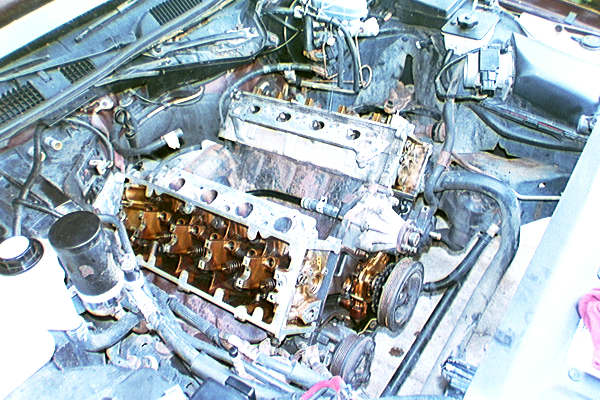This is a pushrod engine. It's not normal as it's a prototype 32v 5.0L. It does, however, allow you to see the pushrods coming from the center of the engine up to the head.

Here is a picture of a 4.6L SOHC engine. Notice the curved pedestals that the camshafts ride on. One camshaft per head.

Those may be helpful.
Engine History:
The 302 or 5.0L OHV Pushrod V8 debuted in 1968 as a derivative of the 90* V8 family of Ford engines. The family of engines dates back to the 260 first released in 1962. The Mustang has had the 302 as an option from 1968-1973, 1975-1979, and from 1982-1995.
Properly cared for, a 5.0L engine should turn 120,000mi onto the clock before any noticable performance drops occur. It's a very reliable and proven engine.
The 281 (4.6L) has been around since 1992. It was first placed into the Crown Victora sedans 11 years ago. The Thunderbird got it in 1994, I believe, and the Mustang in 1996. There are a couple different varients of the engine. The SOHC, found in the Mustang GT, and the DOHC Cobra engine found in the Mustang Cobra. If you are comparing 5.0 vs 4.6, I'm going to assume your looking at the SN95 series cars, and quite frankly, the GTs. The DOHC Cobra is expensive as all get out. If you can find one in good condition, with low mileage for less than $16,000, you're doing well.
So far, the 4.6L has proved to be a sound, reliable engine, with few problem areas. The intake manifold on the older GT's is definately one issue. There is a replacement recall which allows you to get a different one when you stock one pops. You'll find few 4.6 GTs with 100k or more on them.
Engine performance:
The 5.0L can be built for whatever you want it to do. There is an aftermarket product to meet your needs. You can retain mostly stock driving charachteristics with a 320hp combo that'll set you back about $2500, new. If you can do the work 320hp is about $2000. Or you can build a streetable engine to make as much as 375hp with EFI on the 302, or going to a stroker can net you N/A performance in excess of 400hp. Spending under $4000 for a streetable 400hp engine isn't hard to do with the stroker 5.0, providing you can do the work. You can get a fully assembled 306 long block and slap heads and a cam into it for well under $5000 and make 350hp+. Incon makes a twin turbo kit that can push an otherwise stock 5.0 to over 400hp easy for about $4000. Adding a small supercharger and a light N/A build can net well over 350hp for under $3000. An intercooled S/C like ATI Procharger can make 450hp pretty easy, again for around $4000. If you really wanna go nuts, the sky's the limit. If you're on a really tight budget, slap a 125hp shot onto the SN95 5.0 for $500.
The 4.6L can make power with some S/C kits out there as well. If you plan on going N/A, you might be able to pull out 320hp by doing a PI head swap, and adding some other parts. You can pull it off for under $2500 if you can do all the work. You'll probably have to be keeping the CR high to pull it off.
The 4.6L isn't as strong as the 5.0L is, stock for stock.
In stock form, the pre 99 4.6L is NOT more rev happy than the 5.0L OHV pushrod engine. I don't know why people keep saying that it is. Just because a car is OHC vs OHV doesn't mean on the street one will be more rev happy than the other. Neither the Gen 1 4.6L nor the 5.0L is a happy engine for much above 5,000rpms off the factory floor in the SN95 Mustang. Also, off the floor, the SN95 5.0L will walk a 4.6L. There shouldn't be a lot of debate about that. It's pretty well documented off the floor the 4.6L GT is a low 15 car, while the same really good driver could probably churn a real high 14 out of the 5.0L.
Repair time:
As far as working on the engine, the 5.0L is like a bucket of legos. The 4.6L is more difficult to work on and access. Some people seem to view OHC technology as "black art." Talk to most motorcycle mechanics (not Harley guys), and they're likely to tell you it's not so bad. Accessibility is the name of the game when it comes to easy to work on, and the 5.0L has the advantage hands down.
Expenses. The 5.0L is cheaper to repair. It's computer systems and electronics are less intrustive, and the parts are easier to find. It's a competitive market out there. If you blow something up, the 5.0 is WAY WAY cheaper to repair. Straight from DSS's site.
Quote:
Our 4.6 short blocks feature all the same tricks that our record setting Bullet short blocks feature. Torque plate honing and deck equalization are the key to great ring seal. Forged pistons and rods are what is needed for strength.
You would not believe how many 4.6's with a couple of thousand original miles have been through our shop already. It is very expensive to break one of these motors first and then rebuild it. It was common with 5.0's to blow them up first and then pick up the pieces. If you trashed everything it was no big deal, you were going to buy everything new anyway. Not true with a high buck aluminum block or overhead cam head.
|
What is it you're truely trying to get at with this question,
CactusHugger11?